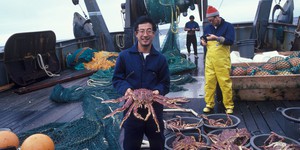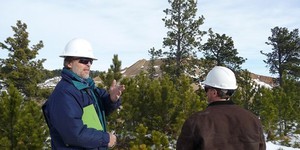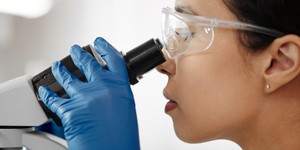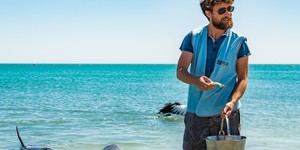Abstract
Have you seen plankton? I am not talking about the evil villain trying to steal the Krabby Patty recipe from Mr. Krab. I am talking about plankton that live in the ocean. In this experiment you can learn how to collect your own plankton samples and see the wonderful diversity in shape and form of planktonic organisms.Summary
Sara Agee, Ph.D., Science Buddies
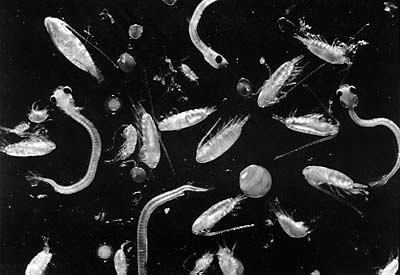
Objective
In this experiment you will make a plankton net to collect samples of plankton from different locations as an indicator of primary productivity.
Introduction
The oceans contain both the earth's largest and smallest organisms. Interestingly they share a delicate relationship linked together by what they eat. The largest of the ocean's inhabitants, the Blue Whale, eats very small plankton, which themselves eat even smaller phytoplankton. All of the linkages between predators, grazers, and primary producers in the ocean make up an enormously complicated food web.
The base of this food web depends upon phytoplankton, very small photosynthetic organisms which can make their own energy by using energy from the sun. These phytoplankton provide the primary source of the essential nutrients that cycle through our ocean's many food webs. This is called primary productivity, and it is a very good way of measuring the health and abundance of our fisheries.
 There are many different kinds of phytoplankton in our oceans. (Photo by Jerry Prezioso, NOAA)
There are many different kinds of phytoplankton in our oceans. (Photo by Jerry Prezioso, NOAA)
One way to study plankton is to collect the plankton using a plankton net to collect samples of macroscopic and microscopic plankton organisms. The net is cast out into the water or trolled behind a boat for a given distance then retrieved. Upon retrieving the net, the contents of the collecting bottle can be removed and the captured plankton can be observed with a microscope. The plankton net will collect both phytoplankton (photosynthetic plankton) and zooplankton (non-photosynthetic plankton and larvae) for observation.
In this experiment you will make your own plankton net and use it to collect samples of plankton from different marine or aquatic locations in your local area. You can observe both the abundance (total number of organisms) and diversity (number of different kinds of organisms) of planktonic forms to make conclusions about the productivity and health of each location.
Terms and Concepts
To do this type of experiment you should know what the following terms mean. Have an adult help you search the internet, or take you to your local library to find out more!
- primary productivity
- plankton
- plankton net
- diversity
- abundance
Questions
- What do plankton look like, where are they found, and how can you collect them?
- What is primary productivity?
- Where do plankton fit into the marine food web?
- How does the abundance of plankton affect productivity of the ocean?
Bibliography
- Here are some of the plankton you might see in this experiment:
HWDT, Date Unknown. Plankton, Hebridian Whale and Dolphin Trust. Retrieved October 31, 2006. - Learn how to build your own sampling equipment and be a junior naturalist:
TPWD, 2005. Texas Junior Naturalists: Sampling Equipment You Can Build, Austin, TX: Texas Parks and Wildlife Department. Retrieved October 31, 2006. - This article describes who is being eaten and who is doing the eating in a marine food web:
MarineBIO.org, 2002. The Grazers and Predators, MarineBIO.org. Retrieved October 31, 2006. - Read this article to learn the basic principles of biological oceanography, or the study of living organisms in the ocean:
Brylske, A., Date Unknown. Biological Oceanography: The Living Ocean , Oceans for Youth Foundation. Retrieved October 31, 2006.
Materials and Equipment
- 1 round, plastic embroidery hoop (6–8 inches in diameter)
- 6 feet of relatively thin, strong wire
- 1 pair of panty hose (support panty hose work best)
- 1 large snap swivel (the kind used in fishing)
- 25–30 feet of strong nylon cord
- 1 small jar, vial, or test tube
- several strong rubber bands
- scissors
- needle nose pliers
- empty jars with lids for storing samples
- a low powered stereo microscope or a high powered magnifying lens
Experimental Procedure
- First, you will make a plankton net to collect your samples of phytoplankton. Here are some instructions on how to make your own plankton net from the Texas Junior Naturalists:
- Cut two pieces of wire, each piece about 24 inches (2 feet) in length.
- Bend the two wires over to form two U-shaped wires and twist together at the top to form a loop (this will be the yoke of the net):
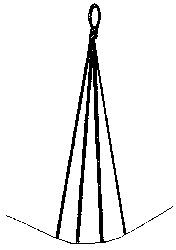
- Cut one of the legs of the panty hose off at the top of the thigh region and cut off the tip of the toe.
- Attach top of the panty hose leg or sleeve to the embroidery hoop by going over the outside of the larger hoop and tucking the top edge of the "net" into the inside of the hoop and then inserting the smaller inner hoop and lock.
- Attach the free ends of the yoke wires to the embroidery hoop by passing the wire around the hoop passing through the net and twisting. The yoke wires must be equally spaced around the hoop and the same length from the rim of hoop to the twisted loop at the top.
- Attach the collecting bottle by inserting into "netting" at the opening in the bottom and securing with several wraps of a strong rubber band.
- Tie the fishing snap swivel to the nylon cord and connect the snap swivel to the yoke loop.
- Now you're ready to sample! Your completed plankton net should look like this:
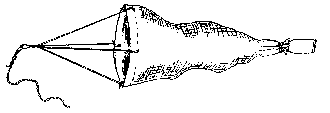
- Now you are ready to visit your collection sites and do some field work. Make a list of locations where you would like to sample and check them over with your parents so they can get driving directions. Some ideas on where to sample could be: a marina, pier, waterfront park, beach, or jetty. If you are lucky enough to have access to a boat, you can make your collections from different locations around a bay or lake. Just bring a map with you to mark your sites on the map. If you do not live near the ocean don't worry. You can do this experiment at local lakes, parks, rivers, or streams.
- You will need to bring all of your equipment to each location, so pack your bag and get ready to go. You will need to bring your plankton net, a map, a data table, empty jars with lids to store your samples, and a permanent marker to label them with. Here is an example of how to make a data table for this type of experiment:
Location Species Density Species Diversity - Visit each site and trawl, or drag, the net behind you while holding the nylon rope. Walk back and forth several times while collecting the sample. Be sure that the net is submerged but still near the surface of the water.
- Pour your sample into one of the holding jars and label it with your name, the date, and the location using a permanent marker.
- When you get back at home, examine the samples using a low powered stereo microscope or a high powered magnifying lens.
- Score the density of the sample by counting how many organisms you see. Write the data in your data table. Which locations had the most phytoplankton? How do you think this affects productivity at this location?
- Score the diversity of the sample by counting the number of different kinds of organisms that you see. Write this information in your data table. Which location had the most phytoplankton diversity? How do you think this affects productivity at this location?
Ask an Expert
Global Connections
The United Nations Sustainable Development Goals (UNSDGs) are a blueprint to achieve a better and more sustainable future for all.
Variations
- You can also count the number of phytoplankton (which appear green or brown) compared to zooplankton (which are mostly marine larval forms) and compare. Do the numbers balance, or is there more of one type than the other? What effect do you think this has on productivity cycles?
- Food chains are very complex. Find out what types of predators and grazers you have in your area. You can find this information from a field guide or from your local Department of Fish and Game. Can you use this information to construct a food web for your local area?
- Some blooms of phytoplankton can be harmful and create an anoxic environment that can suffocate the ecosystem and leave a "Dead Zone" behind. Did you find an excess of brown algae or diatoms? These can be indicators of a harmful algal bloom. Re-visit this location over several weeks to report on an increase or decrease of these types of phytoplankton. Do you think that a harmful algal bloom could be forming in your area?
- For an experiment that studies the relationship between water quality and algal bloom events, see the Science Buddies project Harmful Algal Blooms in the Chesapeake Bay.
Careers
If you like this project, you might enjoy exploring these related careers:



